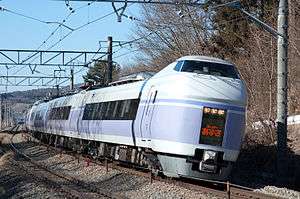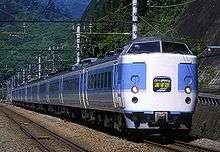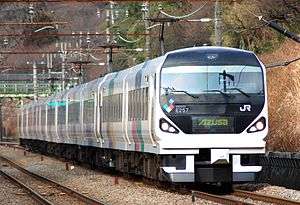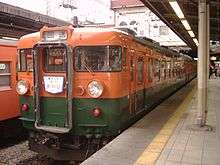Azusa (train)
 E351 series EMU on a Super Azusa service in January 2010 | |
| Overview | |
|---|---|
| Service type | Limited express |
| Status | Operational |
| Locale | Japan |
| First service |
1 October 1957 (Semi express) 12 December 1966 (Limited express) |
| Current operator(s) | JR East |
| Former operator(s) | JNR |
| Route | |
| Line(s) used | Chuo Main Line, Shinonoi Line |
| On-board services | |
| Class(es) | Green + Ordinary |
| Catering facilities | Trolley service |
| Technical | |
| Rolling stock |
E353 series (Super Azusa) E257 series EMUs |
| Track gauge | 1,067 mm (3 ft 6 in) |
| Electrification | 1,500 V DC |
| Operating speed | 130 km/h (80 mph)[1] |
The Azusa (あずさ) and Super Azusa (スーパーあずさ) are limited express services operated by East Japan Railway Company (JR East), which run between Shinjuku and Matsumoto via the Chūō Main Line and Shinonoi Line. The name Azusa is taken from the Azusa River in Matsumoto, Nagano.
Route
Azusa
Shinjuku - Matsumoto - Minami-Otari
(One train a day starts/terminates at Chiba)
Super Azusa
Shinjuku - Matsumoto
Rolling stock
- 183 series EMUs (since 1972, now used for seasonal additional services only)
- 189 series EMUs (since 1975, now used for seasonal additional services only)
- E257 series EMUs (since 2001)
- E353 series EMUs (Super Azusa, from 23 December 2017)[2]
 A 183 series EMU in revised Azusa livery in January 2001
A 183 series EMU in revised Azusa livery in January 2001 An E257 series EMU on an Azusa service in January 2008
An E257 series EMU on an Azusa service in January 2008 An E353 series train in April 2018
An E353 series train in April 2018
From 23 December 2017, new E353 series EMUs are scheduled to be introduced on Super Azusa services.[2] By March 2018, all Super Azusa services will be operated by E353 series trains, and the E257 series trainsets used on Azusa services are also scheduled to be subsequently replaced by E353 series trains.[3]
Rolling stock previously used
- 181 series 10-car EMUs (from 1966)
- 165 series EMUs (from 1966)
- E351 series EMUs (Super Azusa, since 1993 to April 2018)
 A 181 series EMU on an Azusa service in 1975
A 181 series EMU on an Azusa service in 1975 A 165 series EMU
A 165 series EMU An E351 series EMU on a Super Azusa service in July 2010
An E351 series EMU on a Super Azusa service in July 2010
Formations
Azusa
Azusa services are formed of 2+9-car or 9-car E257 series trainsets as shown below, with car 1 at the southern (Chiba/Tokyo/Shinjuku) end. All cars are no-smoking.[4]
| Car No. | 1 | 2 | 3 | 4 | 5 | 6 | 7 | 8 | 9 | 10 | 11 | ||
|---|---|---|---|---|---|---|---|---|---|---|---|---|---|
| Numbering | KuHa E257 | KuMoHa E257 | KuHa E257 | MoHa E257 | MoHa E256 | MoHa E257 | SaHa E257 | SaRoHa E257 | MoHa E257 | MoHa E256 | KuHa E256 | ||
| Accommodation | Reserved | Reserved | Non-reserved | Non-reserved | Non-reserved | Reserved | Reserved | Reserved | Green | Reserved | Reserved | Reserved | |
Super Azusa
Super Azusa services are formed of 4+8-car E351 series trainsets as shown below, with car 1 at the southern (Tokyo/Shinjuku) end. All cars are no-smoking.[4]
| Car No. | 1 | 2 | 3 | 4 | 5 | 6 | 7 | 8 | 9 | 10 | 11 | 12 | |
|---|---|---|---|---|---|---|---|---|---|---|---|---|---|
| Numbering | KuHa E351 | MoHa E351 | MoHa E350 | KuHa E351 | KuHa E351 | MoHa E351 | MoHa E350 | SaHa E351 | SaRo E351 | MoHa E351 | MoHa E350 | KuHa E351 | |
| Accommodation | Reserved | Reserved | Non-reserved | Non-reserved | Non-reserved | Non-reserved | Reserved | Reserved | Green | Reserved | Reserved | Reserved |
History

The Azusa service began on 1 October 1957 as a semi express operating between Shinjuku and Matsumoto. This operated until 24 April 1960 when it was absorbed into Hakuba semi express services.[5]
The Azusa name was revived from 12 December 1966 for use on limited express services operating between Shinjuku and Matsumoto.[5]
The premier Super Azusa service commenced on 3 December 1994 with the delivery of the first new E351 series tilting EMUs.[5]
New E257 series EMUs were introduced on Azusa services from the start of the revised timetable on 1 December 2001.[1]
Smoking was prohibited in all cars from 18 March 2007.
See also
- List of named passenger trains of Japan
- Kaiji, another limited express service operated on the Chuo Line
References
- 1 2 JR新幹線&特急列車ファイル [JR Shinkansen & Limited Express Train File]. Japan: Kotsu Shimbun. 2008. ISBN 978-4-330-00608-6.
- ↑ 来年3月に現行車両「E351系」引退 スーパーあずさ、新型に [E351 series to be retired by next spring with new trains for "Super Azusa" services]. Sankei Photo (in Japanese). Japan: The Sankei Shimbun & Sankei Digital. 29 October 2017. Archived from the original on 22 November 2017. Retrieved 22 November 2017.
- 1 2 JR Timetable. Japan: Kotsu Shimbunsha. February 2015. p. 957.
- 1 2 3 列車名鑑1995 [Train Name Directory 1995]. Japan: Railway Journal. August 1995.
External links
| Wikimedia Commons has media related to Azusa (train). |
- JR E257 Azusa/Kaiji (in Japanese)
- JR E351 Super Azusa (in Japanese)
.svg.png)